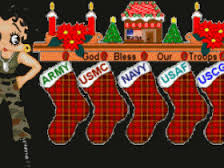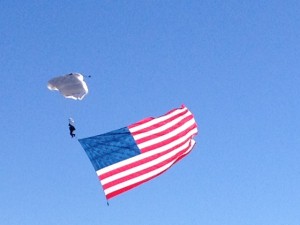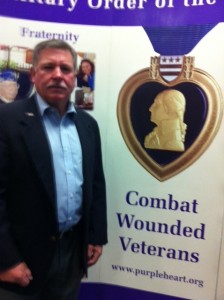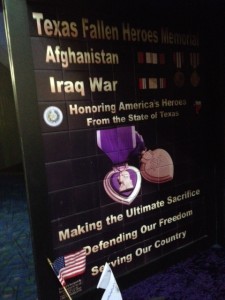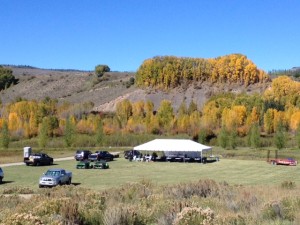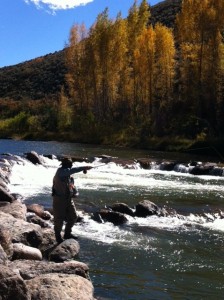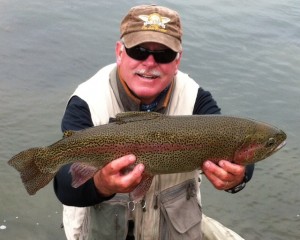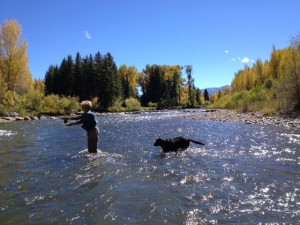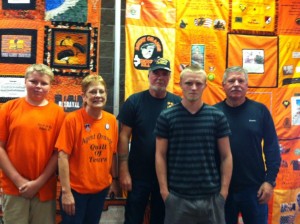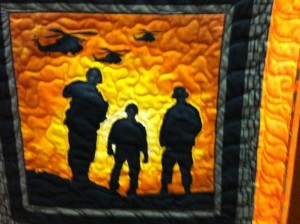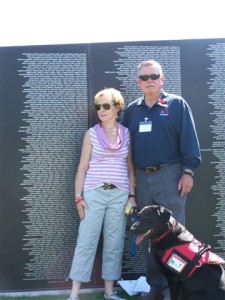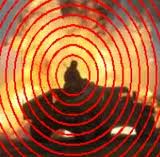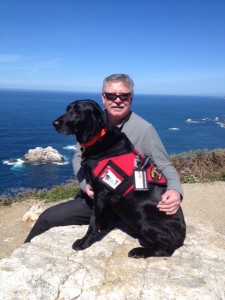Dec
24
YES, MY DEAR VETERAN, THERE IS A SANTA CLAUS
Filed Under American Patriotism, Bless Our Troops, Christmas, Combat PTSD, Dream, Holiday Season, Tears of a Warrior, Tears of Joy | Comments Off on YES, MY DEAR VETERAN, THERE IS A SANTA CLAUS
by Janet J. Seahorn, Ph.D
“Nobody can conceive or imagine all the wonders there are unseen and unseeable in the world.”
Francis P. Church
At this time of year it may be hard for many to believe in much of anything, not to mention a person named Santa Claus. Nevertheless, I still love the story of how the letter, “Yes, Virginia, There is a Santa Claus” came to be. It was written way back in 1897 by a man named Francis Church. Mr. Church was an editor of the Sun newspaper and when receiving a letter from a small girl by the name of Virginia O’Hanlon asking if there was a Santa Claus he wrote his now famous letter. You see, Virginia’s father told her if something appeared in the Sun it must be true. Golly, how times have changed. At any rate, I still find his response to the small Virginia a reminder how important it is to believe in the kinder, sweeter things in life. How miracles surround us every single day, but in our despair we may only be able to see the cruel, bitter, and oftentimes heartbreaking fragments of the moment. Perhaps reading Mr. Church’s famous letter might remind us all of what is really important during this holiday season. His words are as enduring now as they were way back in 1897.
The answer as published in the New York Sun was:
Virginia, your little friends are wrong.
They have been affected by the skepticism of a skeptical age. They do not believe except they see. They think that nothing can be which is not comprehensible by their little minds. All minds, Virginia, whether they be men’s or children’s, are little. In this great universe of ours, man is a mere insect, an ant, in his intellect as compared with the boundless world about him, as measured by the intelligence capable of grasping the whole of truth and knowledge.

Yes, Virginia, there is a Santa Claus. He exists as certainly as love and generosity and devotion exist, and you know that they abound and give to your life its highest beauty and joy. Alas! how dreary would be the world if there were no Santa Claus! It would be as dreary as if there were no Virginias. There would be no childlike faith then, no poetry, no romance to make tolerable this existence. We should have no enjoyment, except in sense and sight. The external light with which childhood fills the world would be extinguished.
Not believe in Santa Claus! You might as well not believe in fairies. You might get your papa to hire men to watch in all the chimneys on Christmas eve to catch Santa Claus, but even if you did not see Santa Claus coming down, what would that prove? Nobody sees Santa Claus, but that is no sign that there is no Santa Claus. The most real things in the world are those that neither children nor men can see. Did you ever see fairies dancing on the lawn? Of course not, but that’s no proof that they are not there. Nobody can conceive or imagine all the wonders there are unseen and unseeable in the world.

You tear apart the baby’s rattle and see what makes the noise inside, but there is a veil covering the unseen world which not the strongest man, nor even the united strength of all the strongest men that ever lived could tear apart. Only faith, poetry, love, romance, can push aside that curtain and view and picture the supernal beauty and glory beyond. Is it all real? Ah, Virginia, in all this world there is nothing else real and abiding.
No Santa Claus! Thank God! he lives and lives forever. A thousand years from now, Virginia, nay 10 times 10,000 years from now, he will continue to make glad the heart of childhood.
If you are finding yourself in the Grinch mode, read Virginia’s letter and think about whatever is good, precious, or beautiful in your life and choose to believe.
Nov
13
SALUTING HEROS
Filed Under American Patriotism, Combat PTSD, Peace, PTSD, Service Dogs, Tears, Tears of a Warrior, Veteran's Day, Wounded Warriors | Comments Off on SALUTING HEROS
by Janet J. Seahorn, Ph.D
If you have never been to Lubbock, Texas it is a flat, dry, and very youngAmericanCity. It was founded in 1911 which was a bit surprising considering that today it is home to around 250 thousand people as well as the well-knownTexasTechUniversity. TTU has the largest campus of any university in the United States and an attendance of close to 35,000 students. There are few places one can go where they don’t see some logo or item related to the Red Raiders. I must admit I really liked their black, red, and gray colors…. a very classy look for their entire plethora of apparel, knick-knacks, jewelry, poster, etc. Texas Tech is also home to the largest Vietnam archives in the world. People from anywhere in the world can access their files through internet with little or no cost.
However, here is what impressed us the most about the university and its personnel, it is a very veteran friendly campus and tries to honor its veterans and their families every day. Last week, before Veteran’s Day, it hosted a four day event celebrating veterans and families. On Wednesday they oversaw their first Veteran’sSummit. It was a day of learning about the challenges of returning from war and transitioning into a community where less than one percent of the population has been fighting the last ten years in Iraq and Afghanistan. Various professionals, including Tony and I, spoke of the difficulties of living with Post Traumatic Stress and Traumatic Brain Injuries. A doctor addressed the complexities of vision problems veterans face. Several veterans, including a panel of four young men who served in Iraq and Afghanistan, shared their experiences in combat and how that impacted their ability to reintegrate back into their families and neighborhoods. Their stories were both heartbreaking and informative. COL David Lewis shared what Lubbock is doing for veterans along with how essential it is for every community to have a Veteran’s Court that deals with those who find themselves involved with actions that landed them in jail or mental health facilities.
Friday evening, the community and university put on a banquet for Purple Heart Recipients and their families. Several Gold Star families (those who have lost loved ones) were part of the event and Medal of Honor Recipient, Doc Ballard fromKansas City, was the Keynote Speaker.
One of the most remarkable parts of the four day events was when almost 500 Purple Heart Recipients were treated to the Texas Tech football game. Before the game began, paratroopers floated into the stadium with Old Glory flying behind them. One of the jumpers was Dana Bowman, a veteran who had lost both legs in a fatal skydiving demonstration in 2001. His courage is a testament to how incredibly resilient our men and women in military are when they are in combat and even more so when they return. As he stated in his speech, “It is not the disability, it is the ability” that matters.
For most Americans who have never had to fight for our precious Freedom few realize – especially our young population – what it is to live without Freedom. We must all guard against complacency and never take for granted the gift that each American has been given because of the service of our military. God Bless our armed forces and our many veterans and their families. Freedom is never free. Let’s support and heal all of our veterans every day of every year, not just honor them one day a year. It is the least we can do.
Oct
6
HEALING WATER – HEALING LIVES
Filed Under American Patriotism, Combat PTSD, Dogs, Fishing Therapy, Healing Waters, Life, Project Healing Waters, Tears of a Warrior, Veterans, War, Wounded Warriors | Comments Off on HEALING WATER – HEALING LIVES
by Janet J. Seahorn, Ph.D
So many questions… most unanswered … fill my mind. Questions such as – What is suffering? Why does it exist in our world? How do we lessen the feelings of hurt, pain, anger, and hopelessness? Very few responses are suitable for any one person, any one situation. Yet, it seems like nature is one of the few healers in our world of chaos and woundedness.
Last week we were privileged to be a part of a Healing Waters activity at the Blue Valley Ranch inKremmling,Colorado. Twenty four vets from FortCarson who are part of the FortCarson’s reintegration program and several who had been former members of the military took part in the program. For four days and nights Project Healing Waters Staff, along with community members and fishing guides volunteered their time and boats to wade fish theBlueRiverand float theColorado. Everyone strived to make the veteran’s activity a nurturing and healing experience.
Long before the adventure began, participants began learning about the art and craft of fly fishing. They learned the various life cycles of flies and many even took up fly tying which has proved to be a very important part of their life-long healing. Once the group arrived at the ranch they were fully equipped with expensive fly rods, fishing vests, hats, and other fly fishing necessities. Each veteran was accompanied by a personal guide to assist, coach, and make sure every need was addressed during the four days on the water. BlueValleyRanch is a good steward of the land and the staff works hard to ensure a high level of commitment to their warrior guests.
But here is the fundamental mission of Project Healing Waters Fly Fishing… it is not to merely provide a few lovely days in beautiful surroundings. The primary mission of Healing Waters is to give each wounded warrior an introduction to an activity and potential life experience that can help heal their mind, body and spirit… It is simply not enough to go away for a few days and fish. Staying in touch with the guides, roommates, or others who have touched their hearts is essential. The guides and Healing Waters partners are around to take the participants on future trips. They are available to talk, to go for coffee or a meal, and to merely be an extended part of their new family.
Yes, Healing Waters most definitely provides comfort and hope to any traumatized individual. However, it is people who heal people. It is communities that offer support and nurturing, and it is being with animals and beautiful surroundings in nature that help a wounded soul believe that even in a harsh world, there is still immense beauty waiting to be experienced.
Quite simply it is the unpretentious comfort of nature and humankind that brings one back to believing in the humanity that is still present even if one can’t immediately see or feel its presence.
So, go to the river to heal, and be sure to include your faithful dog companion to complete the experience.
Aug
11
AGENT ORANGE: “QUILT OF TEARS”
Filed Under Agent Orange, Combat PTSD, Healing, Tears of a Warrior, Trauma, Veterans | Comments Off on AGENT ORANGE: “QUILT OF TEARS”
by Janet J. Seahorn, Ph.D
It was during our work in Hot Springs, SD with the American Legion and the “Honoring Our Heroes” event that we were able to view for the first time the “Quilt of Tears”. This is an unbelievable sea of orange fabrics with hundreds of patches depicting the stories of those Vietnam veterans and families who have suffered with the effects of Agent Orange.
Much of what is in this blog will be taken from a pamphlet I picked up at the quilt display. The quilt is being cared for, assembled, and driven across the United States by Shelia and Henry Snyder (amrdangel@aol.com).
Many veterans and their family members still do not know much about the effects of exposure to Agent Orange. An accurate number of casualties is “almost impossible to record due to various reasons, but the estimated number has been at 250,000 for quite a few years”, and the number grows every day. Even today, few Americans know that Agent Orange was a powerful herbicide used during the Vietnam War to deforest the jungle in order to set up base camps for our troops. Understanding the effects of Agent Orange on an individual is frightening. These powerful chemicals could literally take down a thick canopy of trees in a short few days. Think about, if it could destroy these huge trees in a matter of days — imagine what these chemicals could do to the fragile human body.
Exposure to Agent Orange can be fatal. Some of the diseases which are currently thought to be a result of these herbicides are Chloracne, Hodgkin’s Disease, Multiple Myeloma, Non-Hodgkin’s Lymphoma, Peripheral Neuropath, Porphyria cutanea tarda, Prostate Cancer, Respiratory Cancers, Soft-Tissue Sarcoma, Type II Diabetes, and illnesses and birth defects for the veteran’s children.
It is essential that veterans who have been exposed to Agent Orange get regular physicals complete with CAT Scans to detect the chemicals related to cancers. As with all diseases, early detection is critical to positive long-term outcomes.
The “Quilt of Tears” is a non-profit organization and relies solely on private donations. To learn more go to the website: www.agentorangequiltoftears.com. Individuals can get information on how they can create his or her own personal patch for the quilt at this site.
“Fear not my great soldier…for your story shall be passed down through the years because the fabric of your life is sewn into the Quilt of Tears.”
Jul
28
HEARING LOSS – THE TRULY SILENT WOUND
Filed Under Brain Injury, Combat PTSD, Dogs, Healing, Hearing Loss, Heroes With Hearing Loss, Service Dogs, Tears, Tears of a Warrior | Comments Off on HEARING LOSS – THE TRULY SILENT WOUND
by Janet J. Seahorn, Ph.D
Much of the time we write about the challenges of Post-Traumatic Stress, a silent wound no one can see, yet its effects can consume a person’s mind, heart, spirit, and even soul. However, there is a very physical silent wound that many individuals face, especially veterans who have been in combat zones where IEDs, bomb & RPG blasts and other tragic events cause a physical hearing loss.
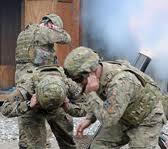 Losing any of our senses makes negotiating the daily routines of life much more difficult. And losing the loss of hearing separates one from the ability to participate in the most common of daily tasks. Simple activities like going to the store and trying to communicate with the checkout person, or straining to understand what your waiter is telling you at a restaurant can be challenging. Consider, also, what it takes to have a conversation on the phone. Most of us take these common everyday tasks for granted. Thanks goodness for new technologies like texting.
Losing any of our senses makes negotiating the daily routines of life much more difficult. And losing the loss of hearing separates one from the ability to participate in the most common of daily tasks. Simple activities like going to the store and trying to communicate with the checkout person, or straining to understand what your waiter is telling you at a restaurant can be challenging. Consider, also, what it takes to have a conversation on the phone. Most of us take these common everyday tasks for granted. Thanks goodness for new technologies like texting.
It was an early Friday morning and I was heading to the airport to catch a flight to Louisville, Kentucky. Tony had accepted an invitation for both of us to speak on several panels regarding hearing loss and combat veterans. In between the acceptance and the trip, he got a special opportunity to spend ten days in Alaska fishing for salmon and halibut. This proved to be an offer he couldn’t refuse. So you guessed it, I was doing this one alone, kind of like Tonto without the Lone Ranger.
Once I arrived in Louisville I had the wonderful privilege of spending several days with four wounded veterans and three of their wives. All of the vets had severe hearing loss from an IED explosion or near a suicide bomber, and one who had contacted an unusual illness that caused him to lose his hearing due to the cartilage in his body being eaten away. Three of the four vets also suffered with pretty severe traumatic brain injuries.
 What was quite amazing about this group was not what they had lost, but how far they had come in addressing their condition and moving forward. And to make this situation even more remarkable was that each had a wife who was incredibly supportive and tenacious on making sure that her husband fought for his recovery as she helped fight for appropriate services in the healing journey. One of the wives had a Master’s degree in Occupational Therapy while another had a background in working with the deaf and was skilled at sign language and other techniques to use when working with individuals faced with hearing loss.
What was quite amazing about this group was not what they had lost, but how far they had come in addressing their condition and moving forward. And to make this situation even more remarkable was that each had a wife who was incredibly supportive and tenacious on making sure that her husband fought for his recovery as she helped fight for appropriate services in the healing journey. One of the wives had a Master’s degree in Occupational Therapy while another had a background in working with the deaf and was skilled at sign language and other techniques to use when working with individuals faced with hearing loss.
What was an Aha Moment for me after being around these couples is the fact that there are “tip” sheets to assist with adjustments to hearing loss.
-Tips like stand still and face the individual with whom you are talking.
-Talk clearly.
-Try to keep to the point and don’t overuse words.
Darn, these were things Tony and I learned the hard way. I could have benefited knowing these years ago. The list reminded me of training our dogs… you do the same things… when giving directions or a command. Stand still. Use minimal words such as stay, sit, down, eat, kennel, etc…Kind of showed us that training ourselves sometimes is very much like training our animal friends.
For any person with a hearing loss and especially our returning veterans and families, get informed about all the new technologies and assist devices that can greatly enhance the ability to function. If you are in this category you will have to be your own fervent advocate. If you aren’t satisfied with your services, keep pushing for any new ideas or programs that are available. Do your Google searches. The Veteran Centers are pretty overwhelmed with the number of veterans needing services, therefore, you will need to be the bull terrier not willing to give up or give in until you are convinced all that can be done, has been done.
Adapted hearing devices are available through many American companies. One such organization is Hamilton CapTel. It produces a caption phone that has been a Godsend to Tony. Hamilton CapTel has just launched a new program called Heroes with Hearing Loss www.heroeswithhearingloss.com The program focuses on education and information for navigating the world of the hard of hearing. Take a look at their video. You may even want to “Like” them on Facebook to get more information.
http://www.multivu.com/mnr/62613-heroes-with-hearing-loss-new-program-debuts-vfw-national-convention
In the end I am reminded of a quote by Joseph Fort Newton. It clearly captures the essence of so many of our military personnel and their families who continue to wake up every day and courageously move forward toward their personal healing and their mission of making a difference for others.
“We cannot tell what may happen to us in the strange medley of life. But we can decide what happens in us, how we take it, what we do with it —– and that is what really counts in the end.”
May
25
EVERY WAR HAS TRAUMA
Filed Under Combat PTSD, Healing, Memorial Day, Post-Traumatic Stress "Injury", PTSD, Stress, Tears of a Warrior | Comments Off on EVERY WAR HAS TRAUMA
by Janet J. Seahorn, Ph.D
Every so often we get asked a question about why past war veterans like those from World War II seemed not to suffer as greatly from Post-Traumatic Stress. Our answer is that “they did” but as in all past wars very few knew what they were experiencing or how to talk about such a silent wound. Who would understand their despair? Who would judge them for being inferior, less courageous? How could they talk about what they were suffering when there were no words/names to this despondency?
Once again, one of our friends sent us an article by Duane Jeffrey, an emeritus professor of biology at Brigham Young University. The article was titled, “Mental Malfunction in Mankind’s Wars. The author gave some staggering statistics about World War II veterans both American, British, and even German troops. It made me wonder, not that these veterans were troubled by Post-traumatic Stress, but that they somehow were able to move forward each day not ever knowing or understanding what was happening to them.
When we read about the various battles of any war, it is pretty obvious that the horror and devastation of what our young men and women went through was beyond mere words. Mr. Jeffrey’s writes, More than 1,393,000 U.S. military personnel were treated for psychiatric “breakdowns” in WWII. Forty percent of all medical discharges were for psychiatric reasons. That amounted to 504,000 troops formally discharged due to “psychiatric collapse.” The battle for Okinawa alone produced some 26,000 cases of psychiatric stress and care.
Teams of psychiatrists, social workers, and psychologists tried to screen men headed for combat, to identify which would reach a breaking point and which would not. This proved fruitless: It soon turned out that anyone, everyone, had a breaking point.”
In addition, he went on to write, that during the battle of Guadalcanal more than 500 Marines were reduced to “sensitivity to sharp noises, periods of amnesia, tendency to get panicky, tense muscles, tremors, hands that shook. … Men were frequently close to tears or very short tempered.”
According to Dr. Jeffery’s research, a report in 1946 indicated that severe emotional trauma in infantry soldiers occurred “in the first 90 days of combat”. The article went on to state that “of those soldiers who survived 60 days of fighting on Normandy’s beaches and the hedgerows immediately inland from there, fully 98 percent… became psychiatric casualties”.
After reading this article, it made me pause to once again wonder how much our current military can take when being deployed for so many tours. Since we have known about these statistics for decades, why are we asking so few to continually sacrifice so much? Surely as a nation we can and should do better.
Over this Memorial Day weekend, be sure to not only thank every veteran you may know, but to pray for those and their families still serving.
And lest we forget, remember those who made the supreme sacrifice and never returned home.
May
2
Warrior’s Journey Home
Filed Under American Patriotism, Combat PTSD, Events, Healing, Journey, PTSD, Tears of a Warrior, Veterans, Warriors Journey Home, Wounded Warriors | Comments Off on Warrior’s Journey Home
by Janet J. Seahorn, Ph.D
Religion does not heal. People heal people. They do it through love, generosity and acceptance. Look. Listen. Heal. Oh so simple yet so difficult to achieve.
For four days we were with a group out of Canton, Ohio who were conducting a conference called the Warrior’s Journey Home. It started with the interesting collaboration of a church pastored by Dr. John Schlup and a Seneca wise woman, Shianne Eagleheart. Through Shianne’s sharing, she taught several members of the congregation the spiritual and physical healing of the Healing Circle. My brother, John, has been a living example of the power of Native American spiritual customs and blessings in Hot Springs, South Dakota.
The purpose of the Healing Circle is to give an individual a safe, nonjudgmental place to be – to listen – to learn and to share his/her trauma experience(s). Sharing is not an expectation like in many traditional therapy groups. It is merely an invitation if one is inclined to disclose his/her words. The sharing is only for those in the circle to hear. Stories must never be disclosed beyond the circle unless given permission by the person speaking.
So here is the really cool part of the sharing, there is a hand carved stick that looks like a walking stick. However, this stick is truly special because the only person who can speak is the person holding the talking stick. There are no time limits a person has to hold the stick and no one can get up and take the stick from that person. When the speaker is through disclosing his story he will place the stick back in its place or hand it to another person.
Oh, and another powerful trait of a Healing Circle is questions are never asked of the speaker. Wow, unlike modern therapy, there is no interrogation, advice, or “extra” comments. One may be given a hug or a small a glass of water by a listening member, but that’s it. By moving through the circle an environment of listening and caring is generated. Perhaps this is why the Healing Circle is such a special experience for veterans.
To make the experience even more powerful a drum and drummers may be present. Shianne’s partner, Bob honored the group with his handmade drum. Healing Circles often begin with native songs and drumming. The beat of the drum mirrors the rhythm of the heart. This mimics the ancient ceremonies meant to simulate a mother’s heartbeat when the warrior was in her womb. It calms the thoughts and anxieties of the attendees, and gives each person a way to begin and end the Circle experience. Like the mystical poet, Rumi, advises, the circle empowers many thoughts:
“What you seek is seeking you.”
“Most people guard against going into the fire, and so end up in it.”
One of my favorite old Chinese proverbs says it all,
“You cannot prevent the birds of sorrow from flying over your head, but you can prevent them from building nests in your hair.”
Feb
18
AGAINST ALL ODDS
Filed Under Combat PTSD, Healing, Hope, Life, PTSD treatment, Tears of a Warrior, Treating PTSD | Comments Off on AGAINST ALL ODDS
by Janet J. Seahorn, Ph.D
PREFACE
For too many individuals, there may often be days when one feels he/she cannot continue to withstand the struggle and obstacles of the many agonies of the past. The feelings can be overwhelming and consume our minds and bodies with darkness. It is at this time when a favorite, inspirational quote or a poem of encouragement may help us get through a really bad day. It is for this reason, I wrote the poem, Against All Odds. If we believe we can, hopefully, we can. And surely as there is day and night, sunshine and rain, joy and sadness, if we believe we can’t, then we won’t.
AGAINST ALL ODDS
Janet J. Seahorn
Against All Odds I will survive.
Courage and grit will be my guides.
Against All Odds the demons within
May sometimes grow but never win.
Against All Odds I will find joy
Hate and chaos I will avoid.
Against All Odds I’ll fight my fears
And not be afraid of cleansing tears.
Against All Odds I’ll endure my pain
Knowing that rainbows come after a rain.
Against All Odds I shall be kind
Even if anger sways my mind.
Against All Odds I’ll choose to believe
That peace and happiness I can receive.
For this I know without a doubt
Against All Odds I will win out.
You not only can, but will do what needs to be done to be healed, to be whole, to be healthy in mind, body, and spirit…Against All Odds.
Dec
16
UNSEEN WOUNDS
Filed Under Black Lions, Combat PTSD, PTSD, Tears of a Warrior, Veterans, Vietnam Veterans, War, Wounded Warriors | Comments Off on UNSEEN WOUNDS
Guest Blog:
by Jim Fountaine, Vietnam Veteran
A man of eighteen years, barely dry behind the ears hears Uncle Sam’s call and in eight short weeks the change is as radical as a caterpillar into a Butterfly. Only this change has no beauty to it. A young boy is transformed into a soldier, an instrument of war.
The days of taking his girl to Lover’s Leap, skipping class to go fishing are gone. He is thrust into a world of violence against his fellow man. He begins to see the ravages of war. He learns to kill, not for sport or for food, but for territory, ideals. He does learn these skills with dedication and without question because he is doing what he is ordered to do!
Then, suddenly, he is thrust in a world of pain, death, blood and pure fear. He sees things that no amount of education or training has prepared him for. His friends are now few and close, yet distant because getting too close will cause pain when that friend is no longer there. The cold, damp, heat, loneliness become his constant companion. Sometimes he tries to deaden the pain with booze. He fights himself to bury what he sees. He keeps doing his job without emotion because he feels if he feels he’ll go nuts.
Then suddenly it’s all over and he sheds his uniform and finds himself back on main street U.S.A. When he sees his old school mates he finds he no longer has anything in common with them. He cannot talk about his experiences because they won’t understand. He finds he has had his youth robbed from him. He no longer trusts those around him with the ease he once did.
He has wounds you cannot see; not wounds of the body but wounds of the soul, the mind and the spirit, and no one can see them. No one can see the scars. He drifts back into a time when he felt the pain for real. He seeks out answers he cannot find. At times he feels out of control, so tries to find things he believes that will give him control like booze, drugs or he buries himself in work almost to the point of exhaustion.
He withdraws from relationships for fear of loss. He rejects authority for that authority brought him harm in the past. He feels alone in a vast world that doesn’t seem to care. He hurts, but no one can see the wounds; no one hears his cries for help. He is judged by people by what they see on the surface. They don’t see the Unseen Wounds in him. They don’t hear his silent cries and all he can do is ask, “Why can’t you see what this is doing to me?”
Oct
31
STRENGTH OF SPOUSES
Filed Under Combat PTSD, Healing, Spouse, Stress, TBI & PTSD, Tears of a Warrior, Trauma, War | Comments Off on STRENGTH OF SPOUSES
by Janet J. Seahorn, Ph.D
In the past few years, I’ve written countless blogs on the strength and endurance of our veterans. However, the other side of that coin is the strength and endurance of their spouses. Several days ago we received an e-mail from a spouse who had heard about us and our book through an article that appeared as a Wyoming magazine article. She wrote about the challenges of married life with her veteran husband. A situation that became even more desperate after he suffered a traumatic brain injury (not from combat) that she wrote, “took him totally out of commission”. The e-mail went on to describe how other people did not see the depth of his many wounds, but she was faced with them daily enduring aggressive behaviors and foul language.
The injury occurred in 1998, but it was not until 2001 that the situation became too difficult to bear. I was his sole caregiver & therapist. When things got bad, I was the human standing in front of him as his anger came out.
… There were many days of not sleeping and warding off his craziness. In the first two years after his head injury, we almost lost the house twice. We literally lived in a wooden tent – the house was emptied out of furniture and appliances as the sheriff’s department kept impounding our possessions because we couldn’t pay our bills – possessions which ended up on the court house steps selling for $1. My daughter and I sought safe shelter six times in those two years to get away from him and his outbursts – the first time was on her 10th birthday.
One may think, wow, this sounds pretty darn extreme, yet, due to the lack of available resources in her area, obtaining services was nearly impossible. Her state of affairs is not unlike many of our returning military people and their families. Many spouses are drained of energy trying to keep their loved one out of jails and mental health institutions. What makes her story even more thought-provoking is her educational credentials, during all the turmoil she went back to school and obtained a Master’s degree in mental health. Yet, she has had to fight her own demons brought on by the many years of being exposed to an unpredictable and toxic home environment.
With her educational background she states, I have dissected trauma and I understand the roots of it more than most people.
And perhaps, her most profound statement,
Unfortunately, the war doesn’t stop when they come home. They never leave the ambush; it can haunt them for the rest of their lives. They are eventually removed from the war situation and are not confronted with that type of environment every day (other than their memories). Their spouses and children aren’t so lucky. They too have to live with the aftermath of war.
Thank you, Carol, for your introspective thoughts, your daily courage, and your persistence to keep going even when it would be easier to give up. You are certainly one of our country’s many amazing military spouse.



